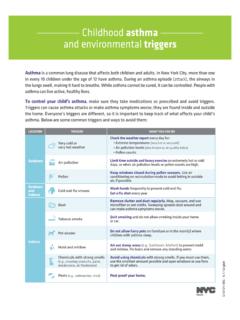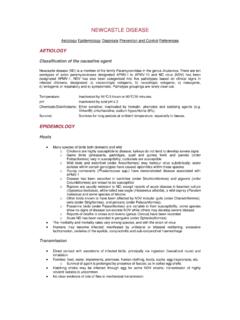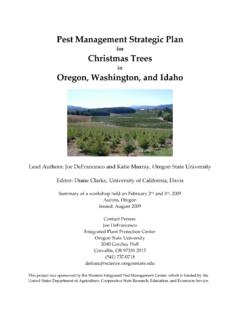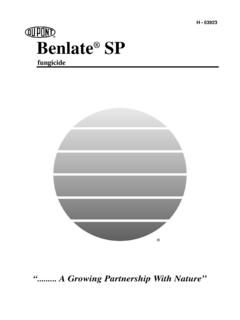Transcription of Tick Management Handbook - ct.gov
1 Tick Management Handbook An integrated guide for homeowners, pest control operators, and public health officials for the prevention of tick-associated disease Revised Edition Prepared by: Kirby C. Stafford III, Vice Director, Chief Entomologist Connecticut Agricultural Experiment Station, New Haven Support for printing this revised edition provided by The Connecticut Agricultural Experiment Station The Connecticut General Assembly Bulletin No. 1010. Stafford The Connecticut Agricultural Experimentation Station Acknowledgements Thanks are given to Dr.
2 Joseph Piesman (CDC, Fort Collins, Colorado), Dr. Peter J. Krause (University of Connecticut Health Center, Farmington, Connecticut), Carol Lemmon (CAES, retired), Bradford Robinson (Connecticut Department of Environmental Protection, Pesticide Management Division), Judith Nelson, Director (retired), and the staff of the Westport Weston Health District (CT), Dr. Terry Schulze (NJ), Dr. Gary Maupin (CDC, retired), and Drs. Louis A. Magnarelli and John F. Anderson (CAES) for reviewing parts or all of the original Handbook . Their comments and suggestions were sincerely appreciated.
3 Thanks are also extended to Vickie Bomba-Lewandoski (CAES) for publication and printing assistance, Heidi Stuber (CAES) for her work in taking some of the tick photographs for the Handbook , and Himanshu Bharadwaj for graphic assistance on the author's tick life cycle diagrams. Dr. Louis A. Magnarelli also provided invaluable editorial and review comments for this revised edition. Sincere thanks are given to the companies, government organizations, foundations, and individuals for permission to use their photographs or illustrations and federal government sources are also gratefully acknowledged.
4 This Handbook would be incomplete without their contributions. Photo Credits Many of the pictures and illustrations in the Handbook are those of the author or staff at The Connecticut Agricultural Experiment Station (CAES). All of the pictures are numbered and source credits provided below. Some sources also are otherwise noted in captions. Requests for use of photographs and illustrations belonging to the author and CAES may be directed to the author. Permission to use any other material must be obtained from the original source. Pfizer Central Research (Groton Point Road, Groton, CT): 1, 7, 16, 17, 22, 27, 30, 31, 47, 49, 51, 53-54, 65- 68, 104, 105.
5 Centers for disease Control and Prevention: 15, 32, 38, 40, 41, 44, 55, 57-58, 60-63, maps of Lyme disease and Rocky Mountain spotted fever cases. United States Department of Agriculture: cover (tick), tick morphology figure (adapted from Strickland et al. 1976), 75. American Lyme disease Foundation (Somers, NY): 10, 11, 23, 97. Barnstable County Cooperative Extension (Massachusetts): 76. Vector-borne disease Laboratory, Maine Medical Center Research Institute (Portland, ME): 37. United Industries (Spectrum Brands): 72. Ric Felton (Goshen, CT; ): 14.
6 Jim Occi (Cranford, NJ): 12, 45, 101. Lynne Rhodes (Old Saybrook, CT): 48, 50, 52. Steven A. Levy, DMV (Durham, CT): 64. CAES: Jeffrey S. Ward, 6; Paul Gough, 74; Uma Ramakrishnan, 90-91; Jeffrey Fengler, 98;. Heidi Stuber, 24-26, 28-29, 33-36, 39, 42-43, 46; Anuja Bharadwaj, 112, 113; Kirby Stafford, cover (landscape), 2-5, 8-9, 13, 18-21, 56, 58-59, 69-71, 73, 77-89, 92-96, 99-100, 102-103, 106-111, 114. Disclaimer Mention of a product or company is for informational purposes only and does not constitute an endorsement by The Connecticut Agricultural Experiment Station.
7 Published Fall 2007. 2007 The Connecticut Agricultural Experiment Station Bulletin No. 1010. Stafford The Connecticut Agricultural Experimentation Station Table of Contents Introduction .. 1. Ticks of the Northeastern United States .. 3. Tick biology and behavior .. 4. Tick morphology .. 6. How a tick feeds .. 7. Tick sampling .. 8. Blacklegged tick, Ixodes scapularis .. 9. American dog tick, Dermacentor variabilis .. 13. Lone star tick, Amblyomma americanum .. 15. Other ticks .. 16. Tick-Associated Diseases .. 20. Lyme disease .. 21. Southern tick-associated rash illness.
8 26. Human babesiosis .. 27. Human granulocytic anaplasmosis .. 28. Human monocytic ehrlichiosis .. 29. Rocky Mountain spotted fever .. 30. Tick paralysis .. 32. Tularemia .. 32. Powassan encephalitis .. 33. Tick-borne relapsing fever .. 33. Colorado tick fever .. 33. Bartonella infections .. 33. Lyme disease in companion animals .. 34. Personal Protection .. 35. Tick bite prevention .. 35. Tick removal .. 37. Topically applied insect repellents .. 39. Human Lyme disease vaccine .. 43. Integrated Tick Management .. 44. Landscape Management .
9 46. Organic land care practices .. 50. Environmentally friendly lawns and backyard wildlife programs .. 50. Management of host animals .. 52. Prevention of tick-associated disease in companion animals .. 62. Area-wide Chemical Control of Ticks .. 63. Acaricides used for tick control .. 64. Homeowner application of acaricides for tick control .. 65. Commercial application of acaricides .. 66. An acaricide primer .. 68. Additional sources of information about pesticides .. 69. Biological Control of Ticks .. 70. Selected Bibliography and References.
10 71. Bulletin No. 1010. Stafford The Connecticut Agricultural Experimentation Station Preface The original 2004 edition was published as part of a community-based program for the prevention of tick-borne illness supported through a cooperative agreement with the Centers for disease Control and Prevention (CDC). Of the 10,000 copies originally printed, very few remained after wide distribution through Connecticut, New England and elsewhere. The publication was also available online from The Connecticut Agricultural Experiment Station's website ( ).















